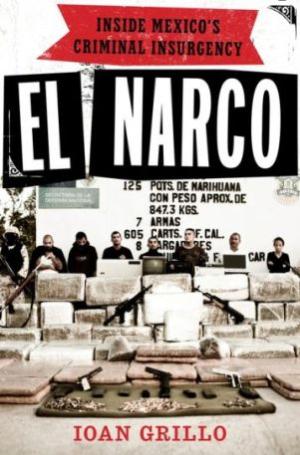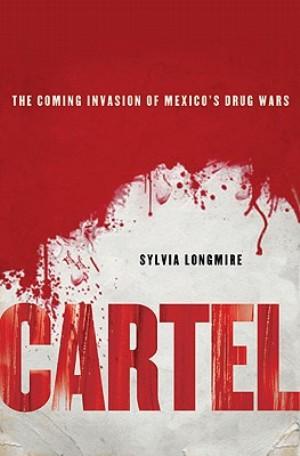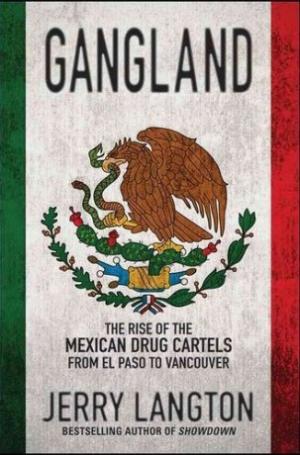Consequences of Prohibition
Drug War Issues
Politics & Advocacy
Cartel: The Coming Invasion of Mexico's Drug Wars, by Sylvia Longmire (2011, Palgrave/Macmillan, 248 pp., $26.00 HB)
El Narco: Inside Mexico's Criminal Insurgency, by Ioan Grillo (2011, Bloomsbury Press, 301 pp., $27.00 HB)
Gangland: The Rise of Mexico's Drug Cartels from El Paso to Vancouver (2012, Wiley, 276 pp., $22.95 PB)

The soldiers would order everyone off the bus, then randomly inspect luggage. Afterwards, everyone would trudge back onto the bus, and off we'd go, past a last sign proclaiming, "Thank you for your cooperation in the permanent campaign against drug trafficking." I never saw the soldiers actually find anything.
Funny thing about those checkpoints -- they never moved. Year after year, there they were in the same places. Of course, everyone in the area, including the dope growers up in the mountains and the traffickers who moved the weed, knew exactly where they were and simply went around them or paid the local military commander to look the other way when a load needed to pass.
But those checkpoints were there, and the Mexican government could point to them and say, "Look, we're doing our part." That Potemkin village-style "war on drugs" worked for Mexico for many years. In the '70s, the '80s, the '90s, observers would note sardonically that Mexico was not suppressing the drug trade so much as managing it.
Of course, it helped that Mexico was then under the venerable grip of "the perfect dictatorship," the one-party rule of the PRI that had governed the country more or less since the end of the Mexican Revolution in 1919. The lines of authority were clear, PRI officialdom was happy to take traffickers' bribes and keep a semblance of order in the underworld, and those bundles of pot trickling down out of the mountains became a roaring river of reefer flowing to the insatiable north.

Back then, one man, Miguel Angel Felix Gallardo, was the undisputed godfather of the Mexican drug trade. To avoid unnecessary strife, he and his lieutenants divvied up the plazas, or franchises for a particular smuggling location, among themselves, creating the Tijuana cartel (the Arrellano Felix brothers), the Sinaloa cartel ("El Chapo" Guzman and the Beltran Leyva brothers), the Juarez cartel (Amado Carrillo Fuentes, "The Lord of the Skies," and family), and the Gulf Cartel (Osiel Cardenas). Business was good. Profits from pot were plentiful, and in the 1980s, a new revenue stream, Colombian cocaine, only added to the permanent fiesta.
Yes, there were drug killings back then. You don't rise to the top of a ruthless Mexican drug trafficking outfit by being an overly nice guy. But the violence was minimal compared to the bloodletting that has gone on since 2008, when, under pressure from President Calderon's all-out offensive against them, the cartels turned on each other in a bloody fratricidal struggle, as well as going to war against the police and the military. The killing continues to this day, as does the flow of drugs north and cash and guns south.
And the alarm bells are ringing across the land, thus this spate of books. Former California state intelligence analyst Sylvia Longmire, veteran British-born Latin America reporter Ioan Grillo, and Canadian journalist and author Jerry Langton all describe the evolution of the cartels from their humble Sinaloa roots to their positions today as hugely wealthy, murderously violent drug trafficking organizations with a global reach, although they all bring different perspectives into play.

Grillo has spent years working in Mexico, and it shows. He feels more attuned to Mexican culture, although Langton provides some excellent historical background, and his book is the most interested in the broader social phenomena surrounding Mexico's drug wars. Grillo takes the reader into the world of the narcocorridos, the border ballads celebrating the exploits of the traffickers, and their singers, quite a few of whom have been killed for their efforts. He also explores Santa Muerte, the peculiarly Mexican church (or cult, depending on whom you ask), favored by the poor, the delinquent, and the dopers.
Our authors disagree on just exactly what the cartels are. For Langton, they are essentially just frighteningly overgrown criminal gangs; for Grillo, they are a "criminal insurgency;" for Longmire, she of the national security optics, they are closer to terrorists, of whom she cites Al Qaeda and Colombia's FARC in the same breath.
I don't know that I can buy either the criminal insurgency or the terrorist appellation, though. Both insurgency and terrorism imply political, or, more precisely, ideological goals. While the cartels can be said to have political goals, such as putting a paid-off politician in a powerful post, those goals are merely means to the cartels' real ends: making money. Unlike the FARC, who have a strong (if fraying at the edges) revolutionary socialist platform, or Al Qaeda types, with their Islamic fundamentalist credos, as far as anyone can tell, Shorty Guzman could care less about anything other than making money.
Which is not to say the cartels aren't scary as hell. They are an insurgency in so far as they represent a serious challenge to the Mexican state's monopoly on the use of force. And they do. These guys are heavily armed, thanks in part to "straw buyer" weapons purchased in the US, some of them have police or military training (the Zetas in particular have proven to be a paramilitarized menace even to the Mexican armed forces), and they are capable of acts of exemplary savagery. They are also known to roll through cities in convoys dozens of vehicles long, all full of heavily-armed men, in brazen displays of power.
Grillo notes a key turning point: the effort to arrest Gulf cartel head Osiel Cardenas in 2004, a couple of years after he formed the Zetas out of former US-trained elite anti-drug troops. In the good old days of Mexico's "war on drugs," the occasional arrest was understood as part of the game and took place in an almost gentlemanly fashion, at least at the top. But Cardenas didn't go down like that. Instead, his Zetas engaged the military in a day-long running gun battle, viciously defending their chief against the odds until his capture, and continuing to attack even as the military fled with its captive to a local airport and then back to Mexico City. Now, that's what you call a challenge to the state's monopoly on force.
And that was just the beginning. Now, you can go to web sites like El Blog del Narco and read about almost daily pitched battles between narcos and soldiers. And narcos and police. And narcos and narcos. And police and soldiers. And federal police and state police. There is truly multi-sided mayhem going on.
So, what is to be done about it all? None of the authors are very optimistic that anything will turn this around anytime soon. Unsurprisingly, there seems to be unanimity among them that reforming the hopelessly corrupt, complicit, and outgunned Mexican police forces is high on the agenda. A single national police force may be an answer, but that will take years, if it ever happens at all.
Longmire in particular argues for smarter and more law enforcement on both sides of the border, but concedes that it's unlikely to make much difference. In the end, even she suggests that maybe we should think about legalizing marijuana. Grillo suggests that, too, noting that the cartels are making billions a year on Mexican brick weed. All of them note the utter futility of trying to eradicate the trade.
But while Longmire and Grillo talk about legalizing weed, Langton correctly points out that that's a long shot, and even if you legalize marijuana, that still leaves cocaine, heroin, methamphetamine, and Ecstasy for the cartels to traffic and grow rich off of.
None of them directly confront the fundamental root cause of the problem: drug prohibition. The cartels are the Frankenstein's monster of drug prohibition, created by the mad policymakers of Washington and their hunch-backed global anti-drug bureaucracy assistants in Vienna ("Yeesssss, master") and energized by an unending flow of black market dollars. Langton is right -- legalizing marijuana isn't going to do the job by itself, even if it does attack one cartel revenue stream (though that is not an argument against legalizing it).
At this point, even legalizing everything will not make the cartels vanish. They are now too wealthy, too well-established. They've diversified into extortion, kidnapping, and other crimes. They own businesses. They are integrating. Still, ending drug prohibition would take substantial wind out of their sails, much as ending alcohol Prohibition severely weakened, but did not kill off, the US mob. That may be the best we can hope for.
Or, barring that, Langton mentions another possibility, one not spoken much of aloud these days, but one that is being quietly murmured as the PRI appears set to retake the presidency after the July elections. Mexico can either continue down the path of the drug wars and hope the violence subsides, as with the crack epidemic in the US in the 1980s, he writes, "or they can go back to collaborating with the cartels, allowing them to keep the peace in their own way."
This work by StoptheDrugWar.org is licensed under Creative Commons Attribution-ShareAlike 4.0 International
Comments
What happened to personal use in Mexico?
No one seemed to answer my challenge a few weeks ago when I demanded proof that Mexico had in fact okayed personal-use amounts of basically all drugs. To recap, I only made this challenge after a brief tour of Tijuana and surrounding areas. Everyone I spoke with (albeit in crappy Spanish) laughed when I told them about supposed changes made recently in Mexican drug laws. If such personal-use laws were in fact enacted I could find no evidence anywhere for it. Cannabis was still hard to come by and there was always a police fear about even discussing it, "Because police still bust for weed."
So once again: I challenge anyone to come up with some proof that all drugs are now legal to consume in Mex. I mean, are we not talking about the de facto same policy that Portugal enacted several years ago that is now right at our doorstep? More alarmingly for the facts of this supposed tiny sea change, where the fuck are the drug orgy stories from tourists ? So I renew my challenge: Who is mighty enough to provide some evidence on a day-to-day level that Mexico has liberalized their drug policy?
personal use law in Mexico
http://www.usatoday.com/news/world/2009-08-20-mexico-drugs_N.htm
Add new comment